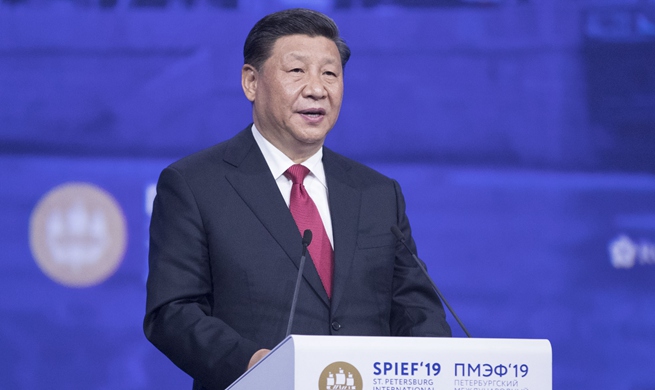HOUSTON, June 8 (Xinhua) -- Oil prices ended mixed for the week ending June 7, with the price of West Texas Intermediate (WTI) for July delivery edged up 0.92 percent and Brent crude oil for August delivery down 1.86 percent.
WTI closed the week at 53.99 U.S. dollars a barrel on the New York Mercantile Exchange, while Brent crude finished the week at 63.29 dollars a barrel on the London ICE Futures Exchange. WTI and Brent have increased 18.89 percent and 17.64 percent, respectively, so far this year.
It has been a volatile week for oil as the two benchmarks sank to their months lows. This was mainly due to the worries about a global recession from the Trump administration's trade tension with China and Mexico and bearish weekly supply-demand numbers for U.S. oil.
Oil prices bounced back later this week as Saudi Arabia indicated that OPEC was close to agreeing to extend a pact on cutting oil supplies beyond June.
Oil prices dropped on Monday, as the market continued to be weighed down by U.S. increased tariffs on Mexico, despite Saudi Arabia's intentions to further supply cut to shore up prices. WTI dropped 0.25 dollar to settle at 53.50 dollars a barrel, while Brent crude was down 0.71 dollar to close at 61.28 dollars a barrel.
On Tuesday, oil prices bounced back, as investors digested the latest speech by U.S. Federal Reserve Chairman Jerome Powell and Saudi Arabia's intentions to further supply cut to shore up prices. WTI increased 0.23 dollar to settle at 53.48 dollars a barrel, while Brent crude was up 0.69 dollar to close at 61.97 dollars a barrel.
On Wednesday, oil prices plummeted on Wednesday, as the market was roiled by a surprising buildup in U.S. crude stockpiles amid growing fears over weakening demands caused by persistent trade frictions. Both WTI and Brent crude slumped more than 1 U.S. dollar. WTI lowered 1.8 U.S. dollars to settle at 51.85 dollars a barrel while Brent crude was down 1.34 dollars to close at 60.63 dollars a barrel.
U.S. crude oil inventories shot up by 6.8 million barrels from the previous week, the U.S. Energy Information Administration reported on Wednesday. For the week ending May 31, the stockpiles registered 483.3 million barrels, about 6 percent above the five year average for this time of year.
Oil prices rebounded again on Thursday, as investors digested Russian President Vladimir Putin's latest remarks on oil policy, saying Moscow would take a joint decision with the Saudi-led OPEC. WTI gained 0.91 U.S. dollar to settle at 52.59 dollars a barrel while Brent crude was up 1.04 dollars to close at 61.67 dollars a barrel.
Oil prices continued to grow on Friday, as U.S. oil rig count fell sharply this week, easing concerns there would be a potential supply glut. WTI increased 1.4 U.S. dollars to settle at 53.99 dollars a barrel while Brent crude was up 1.62 dollars to close at 63.29 dollars a barrel.
Oil prices have kept gaining momentum since the start of the year due to some geopolitical concerns and OPEC's decision of production cut. The momentum has slowed down recently, mainly because of the concerns over downturn in demand for crude oil.
The slowing global economy is a major headwind for crude oil. The slower economic growth of the world, mainly due to the ongoing trade tensions between the United States and China, as well as Mexico, will lead to less demand for oil, which in turn, would put downward pressure on oil prices.
Moreover, a rising U.S. dollar in the past months has dragged down the greenback-denominated crude futures, as the U.S. Dollar Index has been keeping uptrend since mid-2018. U.S. Dollar Index closed the week at 96.56.
The U.S. Dollar Index is a measure of the value of the U.S. dollar relative to a basket of foreign currencies. Oil is mostly traded in dollars all over the world and a stronger dollar pressures the oil demand.
In the near future, analysts believe global oil supply will continue to take the spotlight. Both OPEC and Russia implied an extension of cutting oil supplies beyond June, although more talks were still needed with non-OPEC countries that were part of the production deal. These factors will continue to play their roles in tightening the global supplies, in turn, giving a boost to the prices.
In the meantime, the unexpected stockpile of U.S. crude oil and gasoline has caused concerns in the market as driving and demand for fuels are at their peak in the United States during summer time.

















